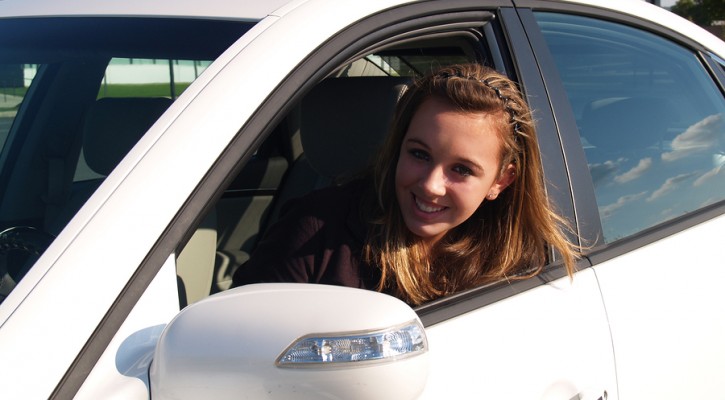Tag Archive: teen driver

Safety on the Road for Teens
November 15, 2006
As teens, we think we know it all, but we don’t. Based on the number of fatal accidents caused by teenage drivers each year, we don’t know some things – like how to drive safely. In “Driving Tips for Teens,” a video presentation that is offered by Allstate Foundation and its partners, there are some startling statistics. The one statistic about teens being 400% more likely to die in a car crash than someone who is in their mid-twenties to mid-thirties should really put a damper on your enthusiasm to go joy-riding with some friends after school.
Luckily, there are a few things we can do to help avoid being a statistic. We’ve all heard the importance of avoiding aggressive drivers and getting out of their way, or defensive driving. We also know that we should buckle our seat belts, keep our hands on the wheel (at all times!), and not talk on cell phones, eat or drink while driving. However, many teens are still doing this. It is also very important to mind the speed limit at all times – they really are there for a reason!
One of the most important things for all drivers to remember is to never drink and drive. Drinking impairs our ability to think straight, and for a teenager or other young, experienced driver, this can spell disaster. Distraction and a reduced ability to react are recipes for a fatal accident. This is another reason why it is never recommended to drive while you’re angry. When your emotions are so strong, your mind is distracted.
The site also mentions a driving program called TeenSmart. It helps parents of teen drivers work with their kids in meeting all the state driver’s licensing requirements without the heated discussions and arguments. There is also cool video and computer based training sessions that teenagers can take that puts us through the paces of what we would likely encounter on the roads. This is just another great tool to help teenagers get experience, increase their skills, and gain additional driving privileges – especially while they are practicing for their driver’s license test.

Car Accident Kills Teen
October 3, 2006
Jeffrey Lee, 15, of Pleasant Grove, Alabama, died September 24 when he was pinned under a relative’s car. Lee apparently put the car in gear, jumped out and was then run over.
Source: Al.com
Safe Driving Lesson Learned
Getting ready to drive is as much a part of motor vehicle safety as actually driving. From the time you enter your vehicle, you are dealing with a potentially deadly machine. Caution must be exercised around the vehicle at all times. Never exit the vehicle without putting it in the proper gear, turning off the ignition, and, if necessary, setting the parking brake.
Before you start your engine:
- Make sure all windows are clean. Remove anything that blocks your view of the road.
- Adjust the seat so you can reach all controls.
- Adjust the inside and outside rearview mirrors. You should not have to lean forward or backward to use them.
- Lock all car doors.
- Put on your safety belts. Ask all passengers to do the same.
- Make sure your car is in park or neutral gear before starting the engine.
Never move your car until you have looked in front, behind and to the side for pedestrians and oncoming traffic. Then, signal and pull into traffic when safe.
Good drivers develop habits that focus their full attention on driving. Some drivers can develop bad habits that can be very dangerous when driving. Some bad habits that distract your attention away from driving are:
- Driving when ill, upset or angry.
- Driving while eating and drinking.
- Driving while adjusting the radio or changing CDs/tapes.
- Driving while calling, answering or talking on a mobile phone.
- Reading while driving.
- Driving while drowsy or fatigued.
Good driving is based on practice and being alert at the wheel from the time you enter the vehicle until you exit.
This post is an excerpt from a recent edition of the Safe Driving Teen Monthly Bulletin. Each month the National Safety Commission publishes the bulletin for teens and parents designed to improve teen driver behavior, attitude, skills, and experience. Subscription Details

Text Messaging Cause of Fatal Teen Crash
August 3, 2006
A 17-year-old likely will face misdemeanor charges after allegedly losing control of his car while text messaging and hitting a bicyclist.
The bicyclist, Jim R. Price of Highlands Ranch, died Friday, two days after the accident.
The spokesman for Douglas County Sheriff’s Office stated that the driver could face a charge of careless driving resulting in death. Under Colorado law, the teen could face up to a year in prison.
Source: USAToday.com
Safe Driving Lesson Learned
Distracted driving: According to a 2002 NHTSA/Gallup Poll, drivers often allow their attention to be diverted from their driving by one or more of the following:
- Cellular phones: About 30% of all drivers use a cell phone while driving to make outgoing or incoming calls on at least some of their driving trips. An estimated 292,000 drivers were involved in a crash attributed to cell phone use between 1997 and 2002.
- Drowsiness: 37% of the driving population says they have nodded off for at least a moment or fallen asleep while driving at some time in their life. An estimated 7.5 million drivers have fallen asleep while driving during a given month.
- Dealing with children: Nearly one in four (24%) drivers deal with children in the back seat of the car while driving.
- Eating or drinking: Half of all drivers (49%) report eating or drinking at least occasionally while driving, with 14% doing so on three-quarters or more of their driving trips.
When you drive, don’t allow poor judgment or distractions to interfere with your driving. Put safety first!
This post is an excerpt from a recent edition of the Safe Driving Teen Monthly Bulletin. Each month the National Safety Commission publishes the bulletin for teens and parents designed to improve teen driver behavior, attitude, skills, and experience. Subscription Details

Car Surfing claims the life of Nashville Teen
August 1, 2006
Police say Shawn Nipper, 16, was car surfing on McGavock Pike in Two Rivers Park on a Saturday night when he died.
Car surfing is where you stand on the roof of a moving car and try to keep your balance while the vehicle is moving. Police say it’s one of the most dangerous stunts you can pull with a car.
The victim’s family says this so-called car surfing is a dangerous, growing trend that parents need to be aware of before it claims more young lives.
Source: newschannel5.com
This post is an excerpt from a recent edition of the Safe Driving Teen Monthly Bulletin. Each month the National Safety Commission publishes the bulletin for teens and parents designed to improve teen driver behavior, attitude, skills, and experience. Subscription Details
Teen Gains New Perspective a Year after Car Crash
July 10, 2006
Alex Hickey, 19, faces surgery to begin reconstructing scarred thighs, the last outward signs of a year-old wreck that occurred when the driver she was riding with lost control on a wet road. She suffered a broken disk in her neck, a broken right femur, a broken left hand and a few broken teeth, four contusions, short term memory loss and a gash in her head that still sloughs off bits of glass; a knee has nerve damage and a foot dropped.
Source: AJC.com
Safe Driving Lesson Learned
You should always drive with caution whenever there is a chance that your traction will be reduced, whether the roads are slick with rainwater or with spilled oil or fuel. If you find yourself driving on slick roads, here are some safety tips to follow:
- Gradually reduce your speed.
- Do not brake hard or suddenly on wet or slippery pavement.
- Avoid sudden acceleration.
- When you change your speed or direction, do so smoothly and gradually rather than sharply.
- Increase your following distance to allow more time to stop.
- If you approach a sharp curve or a hill, grip the steering wheel firmly and give yourself time to slow down.
- If you start to hydroplane, stay calm. Don’t brake suddenly. Take your foot off the accelerator until the tires gain traction with the road, then brake gently.
After a storm, be aware of standing water. Do not drive through large bodies of standing water as it can affect brake performance and the vehicle’s electrical system and can cause engine failure, which could result in costly repairs. If the standing water is concentrated on one portion of the road and only one side of the vehicle goes through the water, the vehicle will tend to pull in that direction. The force of the pull is dependent on the depth of the water and the speed of the vehicle.
As you approach standing water, lift your foot off the gas pedal and check your rearview mirror for vehicles that may be following you too closely. Remember:
- Slow down before hitting the water.
- Turn wipers on before hitting the water.
- Tap brakes as you exit.
- Use caution in checking outside mirrors. Rain can distort or obliterate images.
Do not drive through standing water if you do not know how deep it is.
When roads are wet, stopping distance increases. When braking, friction between your tires and the surface of the roadway affect your stopping distance. Wet roads have less friction and increase the distance it takes you to stop.
Heavy rain reduces your ability to see and be seen. In the daytime, turn on your windshield wipers, low beam headlights and if needed, your windshield defroster. Heavy rain at night can almost blind you. Driving the speed limit under these conditions is too fast. It is always best to reduce your speed limit in this scenario. In rainy weather, the hazard of reduced visibility is compounded by reduced traction. Traction is the grip between your tires and the road. As the moisture reduces friction, tires lose their grip. The distance needed to stop a car increases and the driver has less control of the vehicle. The danger of reduced traction is greatest within the first half hour of rainfall. At that time, the pavement becomes especially slippery, when the rain mixes with the oil and the dust on the surface of the road.
This post is an excerpt from a recent edition of the Safe Driving Teen Monthly Bulletin. Each month the National Safety Commission publishes the bulletin for teens and parents designed to improve teen driver behavior, attitude, skills, and experience. Subscription Details
